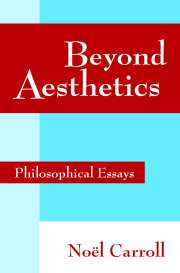Book contents
- Frontmatter
- Contents
- Foreword by Peter Kivy
- Introduction
- PART I BEYOND AESTHETICS
- PART II ART, HISTORY, AND NARRATIVE
- Art, Practice, and Narrative
- Identifying Art
- Historical Narratives and the Philosophy of Art
- On the Narrative Connection
- Interpretation, History, and Narrative
- PART III INTERPRETATION AND INTENTION
- PART IV ART, EMOTION, AND MORTALITY
- PART V ALTERNATIVE TOPICS
- Notes
- Index
Art, Practice, and Narrative
Published online by Cambridge University Press: 19 January 2010
- Frontmatter
- Contents
- Foreword by Peter Kivy
- Introduction
- PART I BEYOND AESTHETICS
- PART II ART, HISTORY, AND NARRATIVE
- Art, Practice, and Narrative
- Identifying Art
- Historical Narratives and the Philosophy of Art
- On the Narrative Connection
- Interpretation, History, and Narrative
- PART III INTERPRETATION AND INTENTION
- PART IV ART, EMOTION, AND MORTALITY
- PART V ALTERNATIVE TOPICS
- Notes
- Index
Summary
The purpose of this essay is to attempt to reorient one of the central questions of philosophical aesthetics, namely, “What is art?” The direction that this reorientation proposes relies upon taking advantage of the practice, or, more aptly, the practices of art as the primary means of identifying those objects (and performances) that are to count as art. Roughly put, the question of whether or not an object (or a performance) is to be regarded as a work of art depends on whether or not it can be placed in the evolving tradition of art in the right way. That is, whether an object (or performance) is identified as art is a question internal to the practice or practices of art. In this respect, the question “What is art?” changes its thrust. “Art” in our query no longer refers primarily to the art object; rather what we wish to know about when we ask “What is art?” predominantly concerns the nature and structures of the practices of art – things, I shall argue, that are generally best approached by means of historical narration.
This essay is written within the context of the philosophy of art as that has evolved in the Anglo-American tradition. The positive proposals I advance, as a result, need to be seen against that background of debate; indeed, part of the confidence that I have in the view developed in ensuing sections rests on my belief that my view manages to avoid the most decisive objections made against earlier, rival positions in the ongoing debate concerning the nature of art. Space does not permit a detailed review of the evolution of that debate.
- Type
- Chapter
- Information
- Beyond AestheticsPhilosophical Essays, pp. 63 - 75Publisher: Cambridge University PressPrint publication year: 2001
- 3
- Cited by



